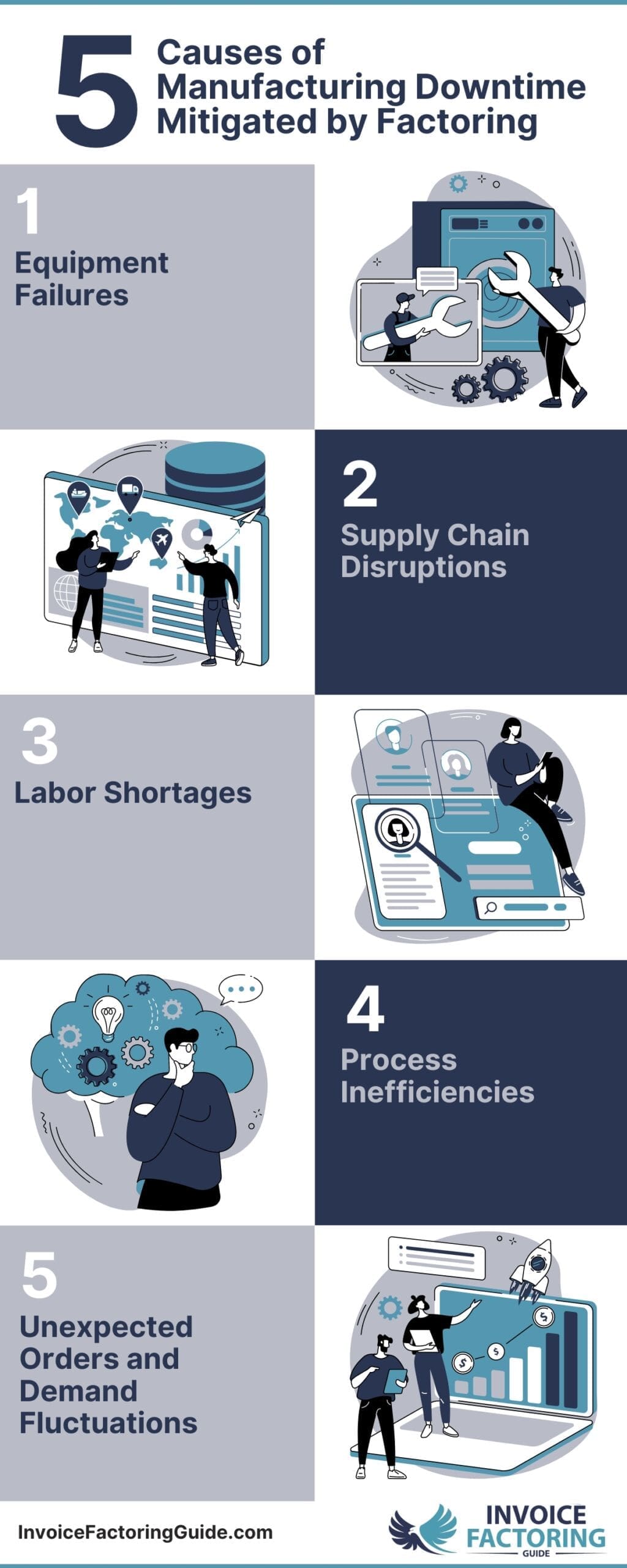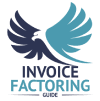
The average manufacturer faces 800 hours of downtime each year, Forbes reports. While some of this is planned, eight in ten manufacturers say they’ve experienced at least one unplanned incident in the past year. The majority has grappled with two or more. This naturally comes at a significant cost to businesses, with some losing tens of thousands of dollars or more each minute operations remain stalled.
Thankfully, preventative measures go a long way toward eliminating unplanned downtime, though small and midsized manufacturing companies often face difficulties when trying to be proactive due to a lack of capital caused by cash flow issues. After all, operating costs are sky-high, and it takes an average of 63 days after a sale is complete for the invoice to be paid in the manufacturing industry, PwC notes. This is where manufacturing factoring comes in. In this guide, you’ll learn how it works and specific strategies for leveraging your factoring advances that can help you mitigate downtime to keep more money in your pocket and build a stronger business.
How Manufacturing Factoring Works
Before we dig into the causes of downtime and how factoring helps you address them head-on, let’s quickly review how manufacturing factoring works.
- Invoice Creation: A manufacturing company provides goods or services to its customers and generates invoices with payment terms, typically 30 to 90 days.
- Submitting Invoices: The manufacturer submits these invoices to a factoring company (also known as a factor) instead of waiting for the customer to pay.
- Invoice Verification: The factoring company verifies the invoices to ensure their legitimacy and confirms the creditworthiness of the customers.
- Advance Payment: After verification, the factoring company advances a percentage of the invoice value to the manufacturer. This advance is usually between 60 and 95 percent of the invoice amount.
- Customer Payment: The factoring company takes over the responsibility of collecting payment from the customers. The customers pay the factoring company directly according to the original payment terms.
- Final Payment: Once the factoring company receives the payment from the customer, it remits the remaining balance of the invoice to the manufacturer, minus a factoring fee. This fee typically ranges from one to five percent of the invoice value, depending on factors such as the customer’s creditworthiness and the volume of invoices factored.
Example Manufacturing Factoring Process
- Invoice Creation: A manufacturer in Ohio sells $50,000 worth of goods to a customer and issues an invoice with a 30-day payment term.
- Submitting Invoices: The manufacturer submits the $50,000 invoice to a factoring company.
- Invoice Verification: The factoring company verifies the invoice and checks the customer’s creditworthiness.
- Advance Payment: The factoring company advances 85 percent of the invoice value ($42,500) to the manufacturer.
- Customer Payment: The customer pays the $50,000 invoice directly to the factoring company at the end of the 30-day term.
- Final Payment: After receiving the $50,000 from the customer, the factoring company deducts a two-percent fee ($1,000) and remits the remaining balance ($6,500) to the manufacturer.
5 Top Causes of Downtime in Manufacturing and How Factoring Helps
Now that we’ve covered the background, let’s explore specific issues that cause downtime in manufacturing and how invoice factoring helps.
1. Equipment Failures
One of the most common causes of downtime is equipment malfunction. This can result from inadequate maintenance, age, or unexpected breakdowns. While regular maintenance schedules are standard, the root causes often lie in insufficient investment in modern, more reliable machinery or a lack of predictive maintenance technologies.

Invoice factoring can play a significant role in helping your manufacturing business avoid equipment failures by providing immediate access to working capital. Additionally, businesses in the construction industry often face similar challenges, making factoring an essential tool for maintaining steady operations in both sectors.
Immediate Cash Flow for Maintenance and Repairs
- Timely Maintenance: Regular and predictive maintenance is crucial for preventing equipment failures. However, cash flow constraints often lead to deferred maintenance. Factoring converts outstanding invoices into immediate cash, ensuring that funds are available to carry out necessary maintenance without delay.
- Emergency Repairs: When equipment unexpectedly breaks down, the immediate availability of funds from factoring can cover the costs of emergency repairs quickly, minimizing downtime.
Investment in Up-to-Date Equipment
- Upgrading Machinery: Older machines are more prone to failures. With the liquidity provided by factoring, businesses can invest in upgrading or replacing outdated equipment. For example, a small manufacturing firm could use the cash from factoring to purchase a new computer numerical control (CNC) machine, which is more reliable and efficient than older models.
- Technology Integration: Factoring can also provide the necessary funds to integrate modern technologies like IoT sensors and predictive maintenance software, which can foresee potential failures before they happen.
Regular Cash Flow for Preventative Strategies
- Consistent Cash Flow: By ensuring a steady cash flow through factoring, businesses can implement and sustain preventative maintenance programs. This proactive approach can significantly reduce the likelihood of equipment failures.
- Training and Development: The funds can also be used to train employees on proper equipment use and maintenance practices, further reducing the chances of equipment malfunction.
2. Supply Chain Disruptions
Delays in receiving raw materials or components can halt production lines. These disruptions can be due to logistical issues, supplier insolvency, or geopolitical factors. Understanding the vulnerabilities in your supply chain and diversifying suppliers can help mitigate these risks.
Manufacturing factoring can be instrumental in helping you mitigate supply chain disruptions by ensuring you have the necessary cash flow to manage and adapt to these challenges.
Prompt Payments to Suppliers
- Early Payment Discounts: By using factoring to access immediate cash, manufacturers can pay their suppliers early, often qualifying for early payment discounts. This not only reduces costs but also strengthens relationships with suppliers, making them more reliable and responsive in times of need.
- Building Supplier Loyalty: Consistently paying suppliers on time or early can build loyalty and trust, encouraging suppliers to prioritize your orders during high demand or when disruptions occur.
Diversifying Supply Sources
- Investing in Multiple Suppliers: With the liquidity provided by factoring, businesses can afford to diversify their supplier base. Having multiple suppliers for critical components reduces the risk of supply chain disruptions if one supplier faces issues.
- Strategic Stockpiling: Factoring can also provide the funds needed to strategically stockpile essential materials or components, ensuring that production can continue even if there are temporary disruptions in the supply chain.
Flexibility in Procurement
- Quick Response to Market Changes: Access to immediate cash flow allows manufacturers to quickly adapt to market changes or disruptions. For example, if a primary supplier suddenly becomes unreliable, the business can swiftly switch to an alternative supplier without worrying about immediate payment issues.
- Dealing with Price Fluctuations: Supply chain disruptions can cause price fluctuations. With factoring, businesses have the cash to absorb these cost increases without halting production.
Investment in Supply Chain Technologies
- Improved Visibility and Management: The funds from factoring can be invested in advanced supply chain management technologies that improve visibility and control. For instance, investing in software that tracks inventory levels in real-time and predicts potential disruptions can help businesses respond proactively.
- Enhancing Communication: Better communication tools and platforms can be funded through factoring, improving coordination with suppliers, and reducing the impact of disruptions.
3. Labor Shortages
Skilled labor shortages can lead to production slowdowns. Training and retaining skilled workers is a persistent challenge. Investing in workforce development and considering automation for repetitive tasks can address this issue.
Invoice factoring can also play a significant role in mitigating labor shortages in the manufacturing industry by providing immediate access to working capital.
Attracting and Retaining Skilled Labor
- Competitive Wages and Benefits: Immediate cash flow from factoring allows manufacturers to offer more competitive wages and benefits, which are crucial for attracting and retaining skilled workers. For example, a company can provide signing bonuses, enhanced healthcare benefits, or retirement plans, making it a more attractive employer.
- Training and Development Programs: Funds from factoring can be used to invest in employee training and development programs. This not only helps in upskilling the existing workforce but also attracts new talent looking for career growth opportunities.
Temporary and Contract Labor
- Flexible Workforce Solutions: When experiencing labor shortages, manufacturers often rely on temporary or contract labor. Factoring provides the necessary funds to hire temporary workers or engage staffing agencies, ensuring production continues without interruptions.
- Quick Response to Demand Spikes: During periods of increased demand, having immediate cash flow allows manufacturers to quickly scale their workforce up or down, meeting production needs without straining financial resources.
Automation and Technological Investments
- Reducing Dependency on Manual Labor: Factoring can fund investments in automation and advanced manufacturing technologies, which reduce reliance on manual labor. For instance, investing in robotic systems for repetitive tasks can fill the gap left by labor shortages.
- Efficiency Improvements: Implementing technologies such as AI-driven quality control or IoT devices for predictive maintenance can increase overall efficiency, allowing a smaller workforce to maintain higher levels of productivity.
Enhanced Recruitment Efforts
- Expanded Recruitment Campaigns: The additional funds from factoring can be used to enhance recruitment efforts, including advertising job openings, attending job fairs, and partnering with vocational schools and universities.
- Relocation Assistance: Offering relocation assistance to attract skilled workers from other regions can be facilitated with the immediate cash flow from factoring.
4. Process Inefficiencies
Inefficiencies in manufacturing processes, whether due to outdated practices or lack of process optimization, can cause significant downtime. Lean manufacturing techniques and continuous improvement programs can help streamline operations.
Invoice factoring can help address process inefficiencies in manufacturing by providing the financial resources needed to optimize operations.
Companies looking to enhance operational efficiency while maintaining financial stability may also consider leveraging a factoring line of credit. This financing option allows businesses to draw funds as needed, helping to maintain cash flow while addressing ongoing inefficiencies.
Investing in Process Improvement Initiatives
- Lean Manufacturing Implementation: Factoring provides the immediate cash flow needed to implement lean manufacturing techniques. This includes investing in training employees, purchasing necessary materials, and redesigning workflows to eliminate waste and improve efficiency.
- Six Sigma Projects: Funds from factoring can support Six Sigma projects aimed at reducing defects and improving process consistency. These projects often require investment in data analysis tools, training, and sometimes consulting services.
Upgrading Technology and Equipment
- Advanced Manufacturing Technologies: With the liquidity provided by factoring, businesses can invest in advanced manufacturing technologies such as IoT, AI, and machine learning. These technologies can optimize production processes, improve quality control, and reduce downtime.
- Modernizing Equipment: Outdated equipment often contributes to process inefficiencies. Factoring allows for the timely upgrade or replacement of machinery, ensuring that production processes are more efficient and reliable.
Enhancing Workforce Training
- Skill Development: Process inefficiencies can often be attributed to a lack of skills or training among workers. Factoring enables continuous workforce training and development programs, ensuring that employees are well-equipped to perform their tasks efficiently.
- Cross-Training Programs: Cross-training employees to handle multiple roles can reduce bottlenecks and improve overall process flexibility. Factoring provides the funds necessary to develop and implement these training programs.
Implementing Process Automation
- Automating Repetitive Tasks: Factoring can finance the automation of repetitive and time-consuming tasks, freeing up human resources for more critical activities. For example, implementing robotic process automation (RPA) can streamline administrative tasks and reduce errors.
- ERP Systems: Investing in Enterprise Resource Planning (ERP) systems can integrate various business processes, providing real-time data and insights that help identify and address inefficiencies. Factoring ensures the availability of funds for such investments.
Conducting Comprehensive Audits and Analyses
- Process Audits: Regular process audits can identify inefficiencies and areas for improvement. Factoring provides the resources to hire experts or consultants to conduct these audits thoroughly.
- Data-driven decision-making: Investing in data analytics tools can help manufacturers gather and analyze data from their operations, leading to more informed decisions that enhance efficiency.
5. Unexpected Orders and Demand Fluctuations
Sudden spikes in orders or changes in customer demand can lead to production adjustments that cause downtime. Implementing flexible manufacturing systems and maintaining a buffer stock can help manage these fluctuations.
Invoice factoring can be a crucial tool for managing unexpected orders and demand fluctuations in the manufacturing industry by providing the necessary liquidity to respond quickly and effectively.
Immediate Access to Working Capital
- Rapid Scaling of Production: When unexpected orders come in, manufacturers need to ramp up production quickly. Factoring provides immediate cash flow, enabling businesses to purchase raw materials, hire additional labor, and increase production capacity without delay.
- Managing Cash Flow Gaps: Factoring helps bridge the gap between fulfilling large orders and waiting for customer payments, ensuring that cash flow remains steady and operations can continue smoothly.
Maintaining Inventory Levels
- Stocking Buffer Inventory: Having a buffer inventory can be crucial for managing demand fluctuations. Factoring provides the funds needed to maintain higher inventory levels, ensuring that manufacturers can meet sudden spikes in demand without production delays.
- Just-In-Time Inventory: For manufacturers using a just-in-time inventory system, factoring can ensure they have the cash to make timely purchases of raw materials and components, aligning supply with fluctuating demand.
Enhancing Supplier Relationships

- Securing Priority Supplies: Factoring allows manufacturers to pay suppliers promptly or even early, fostering strong relationships. In times of high demand, these suppliers are more likely to prioritize your orders, ensuring you get the materials you need without delays.
- Negotiating Better Terms: With reliable cash flow, manufacturers can negotiate more favorable terms with suppliers, such as bulk purchase discounts or flexible payment options, which can be crucial during periods of fluctuating demand.
Flexible Workforce Management
- Hiring Temporary Labor: During periods of high demand, factoring provides the funds needed to hire temporary or contract workers to meet production needs without straining the company’s finances.
- Overtime Compensation: Factoring can cover the costs of overtime pay for existing employees, ensuring that production targets are met without compromising worker satisfaction.
Investing in Technology and Infrastructure
- Advanced Demand Forecasting: Funds from factoring can be used to invest in advanced demand forecasting tools and technologies, helping manufacturers better predict and prepare for demand fluctuations.
- Scalable Production Systems: Investing in scalable production systems and flexible manufacturing processes can help businesses adapt quickly to changes in demand. Factoring provides the financial flexibility to make these investments.
How to Get Started with Manufacturing Factoring
Getting started with manufacturing factoring is straightforward but involves several steps, as outlined below.
Evaluate Your Needs
- Identify Cash Flow Gaps: Assess your cash flow situation to determine the need for factoring. Identify periods when cash flow is tight, such as during peak production times or when waiting for customer payments.
- Determine Factoring Goals: Define what you hope to achieve with factoring, such as improving liquidity, funding growth, or managing demand fluctuations.
Research Factoring Companies
- Industry Experience: Look for factoring companies that specialize in manufacturing and understand the unique challenges of the industry.
- Reputation and Reviews: Check the reputation of potential factoring companies through online reviews, testimonials, and industry references.
- Terms and Conditions: Compare terms, fees, and conditions offered by different factoring companies to find the best fit for your business.
Prepare Necessary Documentation
- Financial Statements: Gather recent financial statements, including balance sheets, income statements, and cash flow statements.
- Accounts Receivable Aging Report: Prepare an aging report of your accounts receivable to show the invoices you intend to factor.
- Customer Information: Provide information about your customers, including creditworthiness and payment histories.
Apply for Factoring
- Submit Application: Complete the application process with your chosen factoring company. This typically involves submitting the necessary documentation and providing details about your business and customers.
- Underwriting Process: The factoring company will conduct due diligence, which may include evaluating your financial health, customer creditworthiness, and overall business operations.
Review and Sign the Agreement
- Factoring Agreement: Once approved, review the factoring agreement carefully. Ensure you understand the terms, fees, advance rates, and recourse options.
- Legal Review: Consider having a legal professional review the agreement to ensure your interests are protected.
- Sign the Contract: Sign the factoring agreement to formalize the relationship with the factoring company.
Submit Invoices for Factoring
- Invoice Submission: Begin submitting invoices to the factoring company. This can usually be done electronically for efficiency.
- Verification Process: The factoring company will verify the invoices with your customers to ensure their validity and confirm payment terms.
Receive Funding
- Advance Payment: Once the invoices are verified, the factoring company will provide an advance payment, typically ranging from 70% to 90% of the invoice value.
- Use of Funds: Use the funds to address your cash flow needs, such as purchasing raw materials, hiring labor, or investing in equipment.
Ongoing Management
- Collections and Payments: The factoring company will manage the collection of invoice payments from your customers. Once the customer pays the invoice, the factoring company will release the remaining balance to you, minus their fees.
- Regular Communication: Maintain regular communication with the factoring company to address any issues or changes in your business needs.
Start Mitigating Downtime with Manufacturing Factoring
If you’re ready to take a proactive approach to mitigating downtime through manufacturing factoring, we can help by matching you with an experienced factoring company that specializes in the industry, offers competitive rates, and has an easy approval process. Request a complimentary rate quote to get started.
Manufacturing Factoring FAQs
What is invoice factoring, and how does it work in manufacturing?
Invoice factoring is a financial solution in which manufacturers sell their unpaid invoices to a factoring company at a discount. The factor advances a percentage (usually 60 to 95 percent) of the invoice value immediately. Once the customer pays the invoice, the factor remits the remaining balance to the manufacturer minus a fee. This process provides quick access to cash, improving liquidity and enabling manufacturers to meet operational needs without waiting for customer payments.
How can invoice factoring help reduce manufacturing downtime?
Invoice factoring reduces manufacturing downtime by providing immediate funds for maintenance, repairs, and equipment upgrades. This ensures that machinery operates efficiently and minimizes unexpected breakdowns. Additionally, the liquidity from factoring allows manufacturers to invest in predictive maintenance technologies and maintain a stock of essential spare parts, further reducing the risk of downtime and keeping production lines running smoothly.
What are the benefits of factoring for manufacturing companies?
Factoring offers several benefits for manufacturing companies: it improves cash flow, enabling timely payments to suppliers and employees; enhances supplier relationships, leading to better terms and reliability; provides funds for equipment upgrades and maintenance; supports handling of unexpected orders and demand fluctuations; and allows investment in process optimization and technology, ultimately boosting operational efficiency and growth.
How does factoring help with equipment maintenance and upgrades in manufacturing?
Factoring provides immediate cash flow that can be used for regular maintenance and timely repairs of equipment, preventing costly breakdowns. It also allows manufacturers to invest in new, more reliable machinery and advanced technologies like IoT sensors for predictive maintenance. This reduces downtime, increases efficiency, and ensures smooth and continuous production.
Can factoring help manage supply chain disruptions in manufacturing?
Yes, factoring can help manage supply chain disruptions by ensuring prompt payments to suppliers, which can strengthen relationships and prioritize your orders. The immediate cash flow allows for strategic stockpiling of essential materials and diversifying suppliers, reducing dependency on a single source. This financial flexibility helps manufacturers respond quickly to disruptions, maintaining steady production.
How does invoice factoring assist in addressing labor shortages in the manufacturing industry?
Factoring provides funds that can be used to offer competitive wages and benefits, attracting and retaining skilled workers. It supports training and development programs to upskill the existing workforce and enables the hiring of temporary or contract labor during peak times. Additionally, it allows investment in automation to reduce dependency on manual labor, addressing labor shortages effectively.
What role does factoring play in improving process efficiencies in manufacturing?
Factoring improves process efficiencies by providing the necessary funds to invest in lean manufacturing techniques, Six Sigma projects, and advanced technologies. This includes upgrading equipment, implementing automation, and integrating ERP systems. Additionally, it supports continuous workforce training and process audits, leading to streamlined operations, reduced waste, and enhanced productivity.
How can factoring help manufacturers handle unexpected orders and demand fluctuations?
Factoring provides immediate cash flow, enabling manufacturers to quickly scale production, purchase raw materials, and hire additional labor to meet unexpected demand. It supports maintaining buffer inventory and ensures timely payments to suppliers, securing priority access to necessary resources. This financial flexibility helps manufacturers respond effectively to sudden market changes and demand spikes.
What are the steps to get started with manufacturing factoring?
To get started with factoring: evaluate your cash flow needs, research and choose a reputable factoring company (Invoice Factoring Guide can help with this), prepare necessary documentation (financial statements, accounts receivable aging report), submit an application, review and sign the factoring agreement, submit invoices for factoring, receive advance payments, and manage the ongoing relationship with the factor. This ensures steady cash flow and operational efficiency.
What should manufacturers look for when choosing a factoring company?
When choosing a factoring company, manufacturers should consider industry experience, reputation, terms and fees, advance rates, and recourse options. It’s important to check reviews, get referrals, and understand the company’s processes and customer service. Selecting a factor that understands the manufacturing sector ensures a smoother, more beneficial relationship.

About Invoice Factoring Guide
Related Articles
Get an instant funding estimate
Results are estimates based on the calculated rate and the total invoice amount provided.
Actual rates may vary.
Request a Factoring Rate Quote
PREFER TO TALK? Call us at 1-844-887-0300










